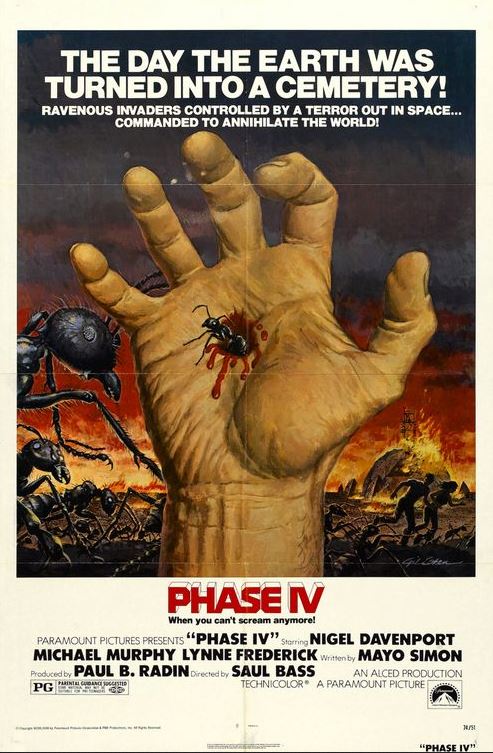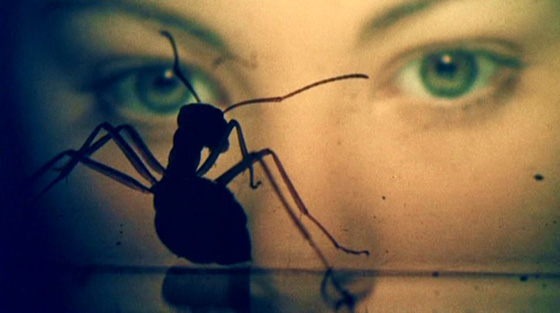
For a long while, Phase IV (1974) was, to me, that VHS box with the ant crawling out of a bloody hole in someone’s palm. It was a misguided Dalí reference, exploitation-style; and at the time it scared me away from renting the film, despite my underage ambition to rent every fantasy, horror, and SF film rated PG (in other words, that which my parents would allow). But finally there was nothing left on the shelf. I took it home and found the film less exciting than the poster art suggested, and over the years only remembered it as that movie in which scientists sit around a lab talking about mutated ants. Recently, I was surprised to find myself interested in Phase IV again. There were reports of a rare deleted ending, from the archives of director Saul Bass, screened in the summer of 2012 at L.A.’s Cinefamily. Jeff McKay posted on the Mobius Home Video Forum, “The sequence exceeded all my expectations. It was about 4-5 minutes long and was a visual and aural delight – one cool abstract and surreal image after the next…It will be hard to watch the theatrical version again as it will now always seem so woefully incomplete.” To see the words “Phase IV” and “delight” in such close proximity was almost too much for me (“woeful,” on the other hand…). I found myself in the position of wishing that I’d been in L.A. to watch Phase IV, of all things. Luckily, the Wisconsin Film Festival has always been good to Madison-based film buffs, and on April 13, Director of Programming (and cult movie fan) Jim Healy brought viewers not only a print of Phase IV and the alternate ending, but film archivist Sean Savage of the Motion Picture Academy of Arts and Sciences and the film’s very embarrassed star, Michael Murphy (of Manhattan, Nashville, and countless better films).
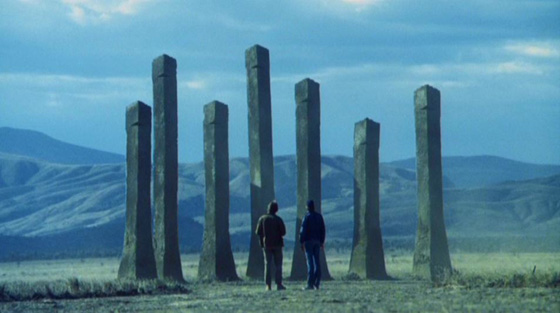
Michael Murphy and Nigel Davenport study some unusual anthills.
After the Q&A ended, Murphy – a great sport – audibly muttered, “Now I never have to watch that film again.” But I found myself being entertained by Phase IV, despite its obvious and numerous limitations. I cannot recommend it without a score of large caveats. If at all possible, the film should be watched in a theater. The photography of the ants, which put me to sleep when I was younger, is really quite remarkable on the big screen, and it’s endlessly amusing to watch those tiny actors hit their marks. These scenes were filmed by Ken Middleham, who had crafted a semi-documentary of insect life called The Hellstrom Chronicle (1971), and would go on to shoot more “micro-photography” for another post-apocalyptic SF film, Damnation Alley (1977). One of the achievements of Phase IV is that it is always pretty clear what the ants are thinking and doing. In one unintentionally funny scene, Middleham and Bass even stage a “tragic,” Gone With the Wind-style shot of dead ants stacked and lined up in rows in one of their subterranean tunnels, implying that the insects are mourning their fallen soldiers. But that’s the other reason Phase IV is best watched at a revival screening. It is much easier to endure the film’s languid pace and pretentiousness if buoyed by the laughter of a packed theater. (The film was featured on Mystery Science Theater 3000 during that show’s run on KTMA public access in Minnesota.) I have had some pretty miserable experiences with classic films being spoiled by inappropriate laughter at revival screenings; but, really, Phase IV is asking for it.
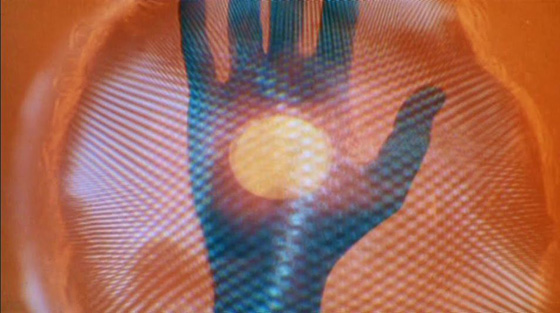
Saul Bass lends a 70's-psychedelic quality to the film's more hallucinatory moments, most especially in the newly-discovered original ending.
The high-concept plot takes place on a near-future Earth which is undergoing environmental changes due to a vaguely-described cosmic event. Cryptologist Jim Lesko (Murphy) joins the isolated and possibly mad Dr. Hubbs (Nigel Davenport, of the similarly eco-horror-themed No Blade of Grass) in the investigation of a colony of mutated ants constructing geometrically-precise monoliths in Arizona (the exteriors were actually shot in Africa, as the producer had already made Born Free there). Hubbs takes a novel approach to stimulating the ant activity: he launches grenades at them. The ants turn hostile fast, attacking in swarms a local farmer’s family and surrounding the domed research facility. After accidentally killing the farmer and his wife by recklessly spraying the surrounding area with their ant-poison sprinkler system, the two “scientists” allow the teenage daughter (Lynne Frederick) to take shelter in the dome. Lesko tries to decipher the ants’ language as a means of communicating with them, but Hubbs quickly declines into violent, obsessive Ahab mode. As the super-intelligent insects take out the radio and air conditioning system, and build towers of bright reflecting light around the dome, Lesko begins to suspect that it’s the ants who are experimenting on them. All of this sounds like perfect fodder for a 70’s genre film: part disaster movie, part Andromeda Strain. But Phase IV is burdened by terrible dialogue and characters who seem to inhabit a sliding scale of stupidity – at the bottom being Lynne Frederick’s teenage innocent, who, in her first moments within the safe confines of the lab, destroys much of their equipment simply because she wants to smash ants (Davenport isn’t terribly bothered, for some reason). What should be an intellectual, mind-bending thriller is, instead, a guilty-pleasure cheesefest; and, of course, I don’t mind that in the least.
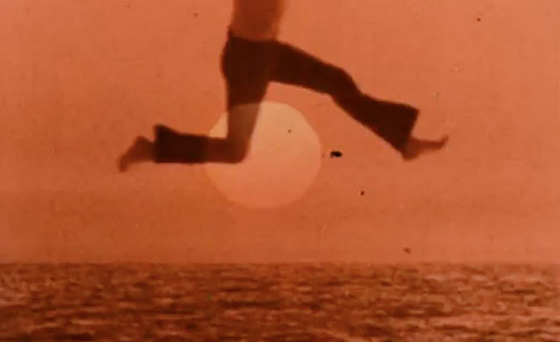
Murphy jumps over the sun, one of the many, many images from the deleted ending's montage.
But the ending, screened after the original cut of the film had played in its entirety, is truly a revelation and worth seeing at least once. More visually ambitious than most of the film’s ninety minutes, it’s a montage of impressionistic, abstract, and surreal images that reminded me, alternately, of Chris Marker’s La Jetee, M.C. Escher, 60’s and 70’s SF paperbacks, and, yes, Dalí. The finale is intended to represent the future of mankind as controlled by the super-ants. We see Murphy and Frederick running hand-in-hand over towers and cities constructed by their new masters. We see humanity confined within giant mazes (the visualization of one of Murphy’s lines – that he knows what a rat in a maze feels like), each person labeled with a number and wearing equipment on the head so the ants can better study the human brain. We see a pelican plummeting, for some reason. We see a boy sitting across from a baboon as if they are psychically communicating. We see a fish with human legs. We see Murphy flapping his arms through the air beside a bird, and jumping over the sun. We see his body merging with Frederick’s, and their faces join together in halves. We see giant ants lording over them all. As with the final cut of the film, the title Phase IV at last appears (the film has no opening credits). The entire deleted scene is a nutzoid, psychedelic freakout, reaching for the stars (or Star-Child); all of it is severely limited by the technology of 1974, the optical effects showing their seams – but it’s still a fascinating collage. If the film had been released with this ending, Phase IV wouldn’t have achieved any greater accolades, but at least it would have had something to hold it in the memory.
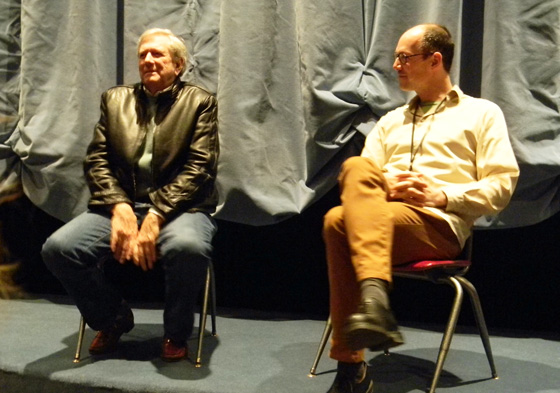
Murphy and the Academy Film Archive's Sean Savage discuss "Phase IV" at the 2013 Wisconsin Film Festival in Madison.
In the Q&A, archivist Savage noted that the studio – a Robert Evans-led Paramount (Murphy made a cocaine-snorting gesture) – tried to make the ending work by layering narration over it, but the end result was even more confusing and overwhelming; in the end, they cut it. A mistake. He also revealed that Bass had shot a prologue: a scene meant to indicate that the ants are communicating with some cosmic power, but which amounted to shots of ants, shots of stars, shots of ants. The scene was dropped and Murphy’s perplexing narration was added to the opening image of the cosmos instead. Murphy discussed the frustrations of having to loop all of his dialogue, and his disappointment with the end result: he felt more attention should have been paid to the acting, and that the film’s intriguing ideas were wasted. He recalled that Frederick’s breasts were tied down throughout the film to give her a more adolescent figure – until the final scene, in which she emerges from the sand to seduce his character. (The actress later married Peter Sellers, he pointed out.) Both Murphy and Savage expressed dismay that the film’s poster was not designed by Bass – Murphy held up images of Bass’s work, including the poster for The Man with the Golden Arm, to demonstrate the man’s talent as a designer. And, of course, the issue of a full restoration and Blu-Ray release was discussed: which is not happening at the moment, due to the expense involved (needless to say, this is a very niche film to begin with). However, there are early discussions of a Criterion box set drawing from the Saul Bass archive, and Savage indicated that if this comes to fruition, the Phase IV ending ought to be included. Stay tuned.
